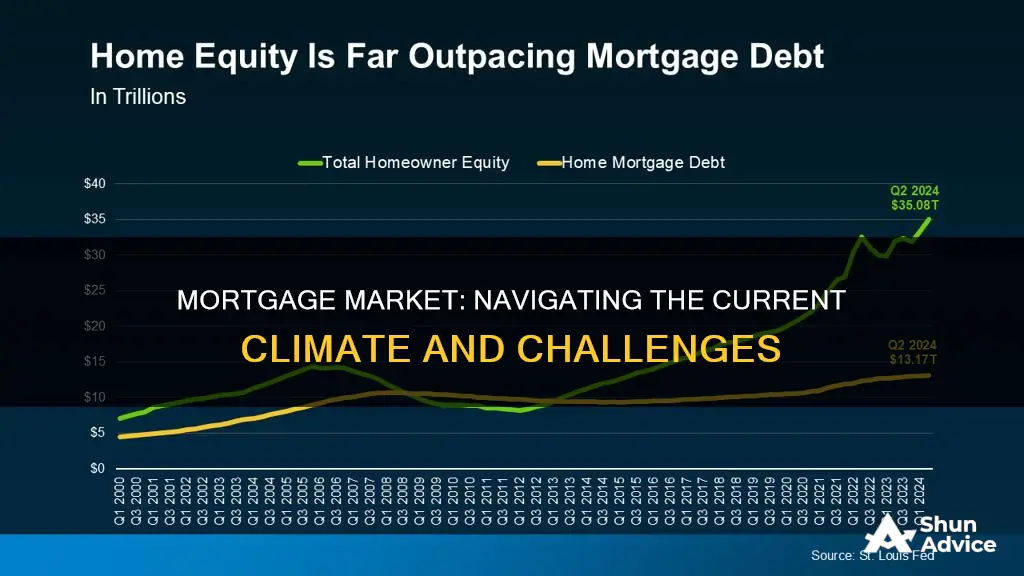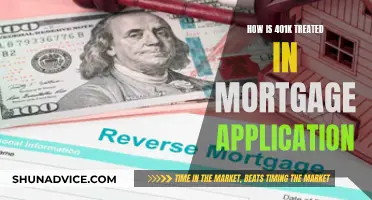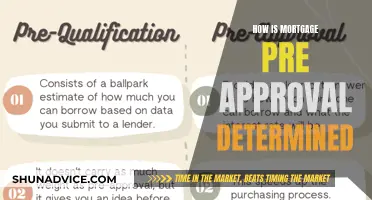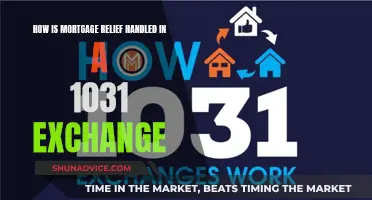
The mortgage market is a complex and intricate business of lending money to buy houses and other properties. It is split into two markets: the primary and the secondary. The primary mortgage market is where borrowers can obtain a mortgage loan from a primary lender, such as a bank, mortgage broker, mortgage banker, or credit union. The secondary mortgage market is where investors buy and sell securitized mortgages, also known as mortgage-backed securities (MBS). This market allows investors to buy MBS, entitling them to principal and interest from mortgage payments. The mortgage market is influenced by various factors, including market conditions, personal financial profiles, and government interventions, such as during the COVID-19 pandemic.
| Characteristics | Values |
|---|---|
| Definition | The business of lending money to buy houses and other property |
| Players | Servicers, investors, government agencies, mortgage bankers, mortgage brokers, mortgage originators, etc. |
| Types | Primary and secondary mortgage markets |
| Primary Mortgage Market | Where home loans originate before they're sold to investors in the secondary mortgage market; primary lenders are typically locally-owned banks |
| Secondary Mortgage Market | A marketplace where investors buy and sell securitized mortgages (i.e. mortgage-backed securities); investors are entitled to principal and interest from mortgage payments |
| Interest Rates | Influenced by market conditions and the borrower's personal financial profile |
| COVID-19 Impact | Mortgage rates fell as the Federal Reserve took actions to enable easier borrowing; the CARES Act allowed impacted Americans to ask for up to a year of mortgage forbearance |
What You'll Learn

The primary mortgage market
The primary market is made up of primary lenders, including mortgage bankers, mortgage brokers, commercial banks, credit unions, and online mortgage companies. These lenders make mortgage loans directly to borrowers. Mortgage bankers are direct mortgage lenders that provide mortgages to borrowers with their own funds or borrowed funds. Mortgage brokers, on the other hand, are liaisons that help borrowers find a lender. Commercial banks offer a full range of retail banking products and services, such as checking and savings accounts, loans, and investments to individuals and businesses. Credit unions are financial institutions operated as not-for-profit organizations.
The primary market serves the homebuying public, focusing on originating loans for homebuyers. It is distinct from the secondary mortgage market, which serves investors and involves the trading of existing mortgage loans, often bundled into mortgage-backed securities. While the primary market is where borrowers achieve their goal of homeownership, the secondary market helps stabilize the mortgage system by providing liquidity to lenders and potentially lowering costs for borrowers.
Understanding Interest-Only Mortgage Amortization
You may want to see also

The secondary mortgage market
Mortgage lenders originate loans and then place them for sale on the secondary market. Investors who purchase those loans receive the right to collect the money owed. The value of mortgages on the secondary market depends on their risk and potential return, with higher-risk loans requiring higher returns. This is why people with lower credit scores pay higher interest rates.
Several players participate in the secondary mortgage market, including mortgage originators, mortgage aggregators (securitizers), and investors. Mortgage originators create the home loans, while mortgage aggregators, or securitizers, buy and securitize the mortgages before selling them to investors.
Retirement Savings: Mortgage Application Considerations for Your 401k
You may want to see also

Mortgage interest rates
The mortgage market is a complex and intricate business of lending money to buy houses and other properties. It is split into two markets: the primary and the secondary. The primary mortgage market is where borrowers can obtain a mortgage loan from a primary lender, such as banks, mortgage brokers, mortgage bankers, and credit unions. The interest rates offered by primary lenders depend on the type of mortgage chosen by the borrower. For instance, a 15-year mortgage typically incurs fewer total interest charges than a 30-year mortgage due to the loan being paid off earlier. Additionally, borrowers can often negotiate a lower interest rate for a 15-year mortgage as there is a reduced risk of default. On the other hand, a 30-year mortgage offers lower payments as they are spread out over a longer period. Adjustable-rate mortgages (ARMs) are a flexible option, usually involving a fixed interest rate for a set period, followed by annual adjustments based on a predetermined index. ARMs also typically include a cap on the maximum interest rate for the loan's duration, making it easier to calculate and budget maximum monthly payments.
The secondary mortgage market is a marketplace where investors buy and sell securitized mortgage loans. Mortgage lenders originate loans and then place them for sale on the secondary market. Investors who purchase those loans receive the right to collect the money owed, including interest. The value of mortgages on the secondary market depends on their risk and potential return, with higher-risk loans requiring higher returns. As a result, individuals with lower credit scores tend to pay higher interest rates. The secondary market includes buyers who are often government-sponsored enterprises (GSEs), such as Fannie Mae and Freddie Mac, which are federally chartered organisations that help maintain cash flow within the mortgage market. These GSEs securitize the bundled loans and resell them as mortgage-backed securities (MBS).
Mortgage Pre-Approval: Essential Step for Home Loan Success
You may want to see also

Mortgage-backed securities
The mortgage market is split into two parts: the primary market and the secondary market. The primary mortgage market is where borrowers can obtain a mortgage loan from a primary lender, such as a bank, mortgage broker, or credit union. The secondary mortgage market, on the other hand, is where investors buy and sell mortgage-backed securities (MBS).
MBS can be issued by government-sponsored enterprises (GSEs) or private financial companies. Agency MBS are issued by GSEs and are considered to have the lowest risk due to government backing. Non-agency MBS are issued by private financial institutions and are not guaranteed, thus carrying higher risk and potentially higher yields. MBS can offer regular income through interest and principal payments, portfolio diversification, and potentially higher yields than other fixed-income securities.
There are two basic types of MBS: pass-through mortgage-backed security and collateralized mortgage obligation (CMO). Pass-through MBS are the simplest form, structured as a trust so that principal and interest payments are passed through to investors. CMOs, on the other hand, consist of multiple pools of securities or "tranches", each with different maturities and priorities in receiving principal and interest.
MBS played a significant role in the 2007-2008 financial crisis, particularly due to the presence of subprime loans. Today, the MBS market remains a major part of the global financial system, with increased regulations and scrutiny from investors and policymakers.
Freedom Mortgage: My Journey to Requesting It
You may want to see also

Government intervention
The mortgage market is influenced by various factors, including market conditions, financial profiles of borrowers, and government intervention. While the market is largely driven by private lenders, government agencies play a role in shaping the landscape. Government intervention in the mortgage market can take several forms, each with its own objectives and implications.
Firstly, governments can directly provide or insure loans to support homebuyers. Historically, government-insured loans have comprised a notable portion of the mortgage market. For instance, in 1960, government-insured loans accounted for 16.5% of the market. Additionally, government-sponsored enterprises (GSEs), such as Fannie Mae and Freddie Mac, are active participants in the secondary mortgage market. These GSEs buy and securitize bundled loans, reselling them as mortgage-backed securities (MBS). By providing liquidity and stability to the market, GSEs help maintain the flow of capital in the mortgage financing system.
Secondly, government agencies can back mortgages to reduce the risk for lenders in case of borrower default. This backing effectively guarantees the loans, making them more attractive to investors and encouraging lending. The Federal Housing Administration (FHA), for example, offers loan options with low down payments and flexible credit requirements. Similarly, the Department of Agriculture sponsors a loan program with 100% financing for buyers in rural areas. Military service members and their spouses can also benefit from VA loans, which offer zero down payments and flexible credit criteria. These programs improve access to homeownership for individuals who might otherwise struggle to qualify for conventional mortgages.
Thirdly, the government can intervene through regulatory measures and interest rate policies. For instance, during the COVID-19 pandemic, the Federal Reserve took actions to lower mortgage rates and facilitate easier borrowing. Additionally, the CARES Act was enacted to provide impacted Americans with mortgage forbearance options, allowing them to request up to a year's worth of forbearance in 6-month increments for government-backed loans. Such interventions can help stabilize the housing market during economic crises and support borrowers facing financial difficulties.
Lastly, the government can implement reforms and provide relief in the secondary mortgage market. This can involve assigning relative risk weightings to highly-rated mortgage-backed securities, potentially influencing investor behaviour and the overall risk appetite in the market. Government interventions in the mortgage market aim to balance various objectives, including promoting homeownership, stabilizing the housing market, and managing risk. These interventions can have far-reaching consequences, impacting borrowers, lenders, and investors alike.
Understanding Mortgage Interest Calculation: What You Need to Know
You may want to see also
Frequently asked questions
The mortgage market is the business of lending money to buy houses and other property.
The primary mortgage market is where home loans originate. Banks, mortgage brokers, mortgage bankers, and credit unions are all primary lenders. The secondary mortgage market is where investors buy and sell mortgages that have been securitized, i.e. packaged into bundles of many individual loans.
Interest rates play a significant role in the mortgage market. When interest rates are high, borrowers are less likely to refinance, and the purchase mortgage market makes up a larger portion of the primary market. Conversely, when rates are low, refinancing becomes more attractive to borrowers.
Government agencies play a role in the mortgage market by backing mortgages, which reduces the risk for lenders if borrowers default on their loans. Examples of such programs include FHA loans, USDA loans, and VA loans.
Mortgage interest rates are influenced by market conditions, such as cost of living, demographics, supply and demand, and an individual's financial profile, including credit score, home location, and loan amount.







